It’s hard to believe that after 7 long years of work, we’re just 2 short weeks away from finally releasing the Floret Original seed varieties out into the world! I feel like I’ve been waiting for this moment for an eternity and can’t wait to see them all growing in your gardens and on your farms this coming season. The official release date is Tuesday, February 6.
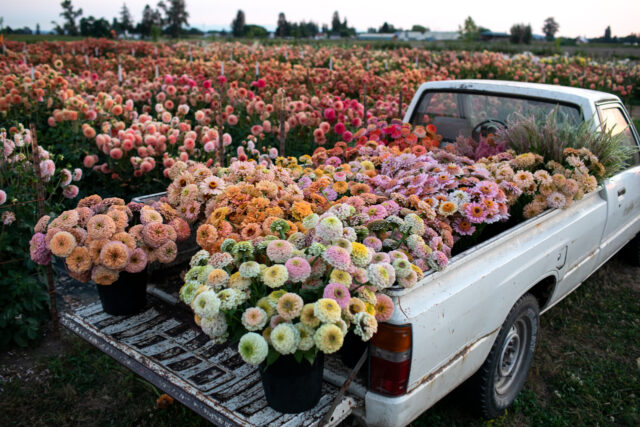 I thought now would be a great time to introduce you to these magical little plant souls and share a bit more about what makes them so special. Each variety has a unique personality and while at first glance some might look a bit similar, they are all quite different when you get to know them.
I thought now would be a great time to introduce you to these magical little plant souls and share a bit more about what makes them so special. Each variety has a unique personality and while at first glance some might look a bit similar, they are all quite different when you get to know them.
 I’ve organized this post into three main sections. First, we’ll explore the 12 celosia varieties that we’re offering, then deep dive into zinnias (we have 10 beautiful mixes!), and end with dahlias which I know so many people are excited about.
I’ve organized this post into three main sections. First, we’ll explore the 12 celosia varieties that we’re offering, then deep dive into zinnias (we have 10 beautiful mixes!), and end with dahlias which I know so many people are excited about.
But before we dive into this introduction, if you don’t already know the backstory about this project, be sure to read Floret Originals: An Update on our Breeding Program.
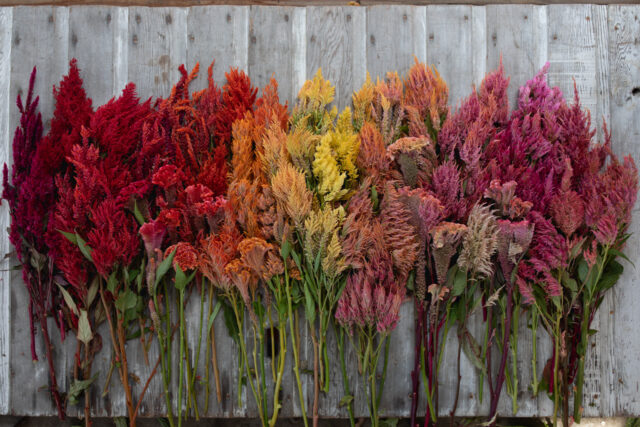 The first group of plants that I want to share with you is celosia. The reason I’ve chosen to highlight them first is because I feel like they are always passed over in favor of fancier, showier blooms!
The first group of plants that I want to share with you is celosia. The reason I’ve chosen to highlight them first is because I feel like they are always passed over in favor of fancier, showier blooms!
 However, if you’re growing flowers to arrange with, these heat lovers are an indispensable addition to your cutting garden and have your back when it comes to churning out bouquet ingredients.
However, if you’re growing flowers to arrange with, these heat lovers are an indispensable addition to your cutting garden and have your back when it comes to churning out bouquet ingredients.
These hardworking plants are vigorous, free-flowering, and easy to grow. Their fuzzy, velvet-like flowers come in a distinct range of shapes, including fans, plumes, and brains that are a wonderful accent for arrangements, plus they can be dried and used any time of the year.

 ‘Autumn Blaze’ is a riot of rich fall tones, including coral, copper, bronze, cherry, rose gold, rhubarb, and amber. The iridescent shimmering plumes come in a multitude of shapes and sizes, including dense candelabras, long, wispy spires, and textural spiky quills.
‘Autumn Blaze’ is a riot of rich fall tones, including coral, copper, bronze, cherry, rose gold, rhubarb, and amber. The iridescent shimmering plumes come in a multitude of shapes and sizes, including dense candelabras, long, wispy spires, and textural spiky quills.
Stocky, heavily branching plants have a unique range of stem and foliage colors. From a distance, the plants look as if they are about to burst into flames!

 ‘Glowing Embers’ is a selection that was made from ‘Autumn Blaze’ and features a narrower range of colors including copper, bronze, coral, smoky rose, muted tangerine, and gold. The velvety plumes come in various shapes and sizes, including dense textural clusters, feather-like wands, and long, slender wisps.
‘Glowing Embers’ is a selection that was made from ‘Autumn Blaze’ and features a narrower range of colors including copper, bronze, coral, smoky rose, muted tangerine, and gold. The velvety plumes come in various shapes and sizes, including dense textural clusters, feather-like wands, and long, slender wisps.
Stocky, heavily branching plants have green foliage with a bronze cast that complements the unusual muted coloring found in the flowers.
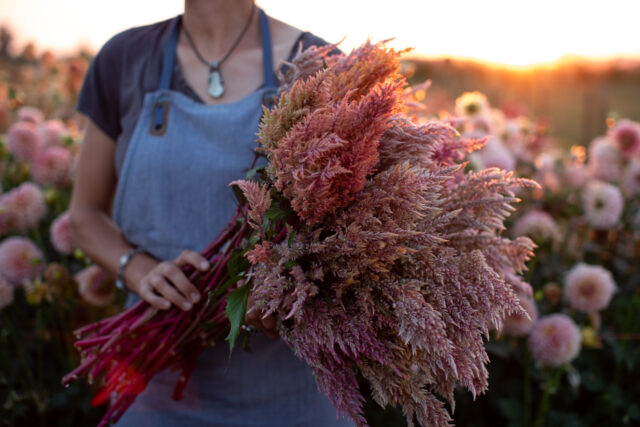
 ‘Rose Gold’ is another special color range that was discovered in ‘Autumn Blaze’ a few years back. The color palette is much more narrow and includes rose gold, blush, and champagne plumes that look as if they have been dusted with iridescent glitter.
‘Rose Gold’ is another special color range that was discovered in ‘Autumn Blaze’ a few years back. The color palette is much more narrow and includes rose gold, blush, and champagne plumes that look as if they have been dusted with iridescent glitter.
The stocky, heavily branching plants have dark ruby-red stems with cranberry-veined leaves that perfectly offset the antique-looking metallic flower heads. They are a flower arranger’s dream!

 If you’re only looking at the plumes cut from the plant, one might think that ‘Vintage Rose’ is the same as ‘Rose Gold’, but the two, while similarly colored, are actually quite different.
If you’re only looking at the plumes cut from the plant, one might think that ‘Vintage Rose’ is the same as ‘Rose Gold’, but the two, while similarly colored, are actually quite different.
‘Vintage Rose’ is twice the height of ‘Rose Gold’ and much more feathery. The flowers are a heartbreakingly beautiful blend of blush, pewter, and sunbleached velvet that looks like it’s from another era. It’s the perfect color range for wedding work.

 Next up is ‘Summer Sherbet’. This beautiful, free-flowering mix produces giant velvety plumes in rose-pink, blush, coral, and the softest peach. The heat-loving plants have light apple-green foliage and long, slender stems that are perfect for arranging.
Next up is ‘Summer Sherbet’. This beautiful, free-flowering mix produces giant velvety plumes in rose-pink, blush, coral, and the softest peach. The heat-loving plants have light apple-green foliage and long, slender stems that are perfect for arranging.
The color palette is super useful for many different types of bouquets because it mixes so well with other ingredients.

 A few years back, Eric (our seed specialist) started experimenting with trying to isolate the most textural, feathery plumes in the ‘Summer Sherbet’ mix, and create a narrower, more vivid color range, and that’s how ‘Spun Sugar’ was born.
A few years back, Eric (our seed specialist) started experimenting with trying to isolate the most textural, feathery plumes in the ‘Summer Sherbet’ mix, and create a narrower, more vivid color range, and that’s how ‘Spun Sugar’ was born.
This beautiful warm, glowing mix produces giant shimmering, textural plumes in a range of peachy tangerine, soft coral, pinky apricot, and smoky rose. These productive plants have long, slender stems, giant spaghetti-like flower heads, and light green foliage.

 In the early days, ‘Summer Sherbet’ was a much broader range of colors which included some yellows and greens. I had always wanted to tease the fresh, clean green out of this variety and finally succeeded with ‘Limonata’.
In the early days, ‘Summer Sherbet’ was a much broader range of colors which included some yellows and greens. I had always wanted to tease the fresh, clean green out of this variety and finally succeeded with ‘Limonata’.
It is a beautiful pale creamy lime blend that looks more like a foliage than a flower. Plants have a vigorous branching habit and produce an abundance of long, wispy chartreuse spires that add a freshness to arrangements. The colors mix well with almost everything. ‘Limonata’ is similar to a hybrid variety of celosia called ‘Sylphid’, but the great thing about this beauty is that you can easily save the seed from it.

 ‘Raspberry Lemonade’ also originated from ‘Summer Sherbet’, but has a much more saturated color range not often found in the celosia family. What makes it so unique is the dusty, smoky coloring that has a sun-faded quality.
‘Raspberry Lemonade’ also originated from ‘Summer Sherbet’, but has a much more saturated color range not often found in the celosia family. What makes it so unique is the dusty, smoky coloring that has a sun-faded quality.
Plants have a vigorous branching habit and produce dense, textural spires in shades of smoky raspberry, sangria, watermelon, and the occasional lemon yellow.
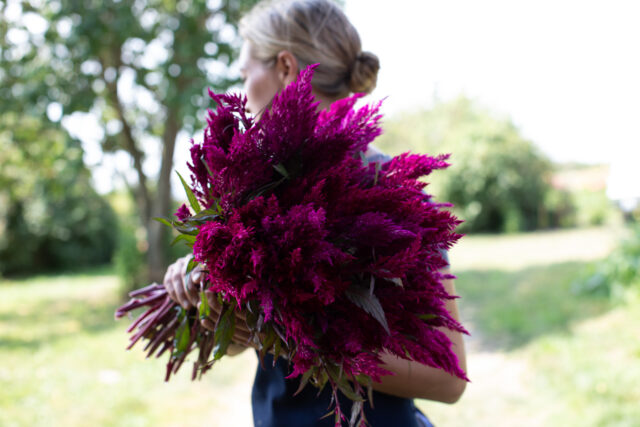
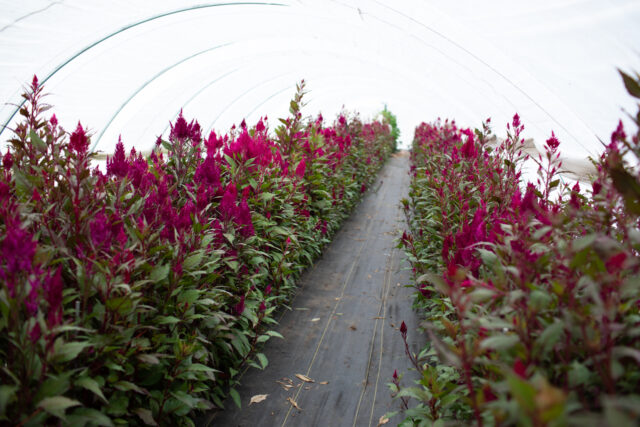 While I tend to be most often drawn to soft pastel colors, there’s always a place for richer, more vibrant tones, too. Sangria Mix is composed of towering deep grape-purple and vivid magenta plumes that draw a lot of attention.
While I tend to be most often drawn to soft pastel colors, there’s always a place for richer, more vibrant tones, too. Sangria Mix is composed of towering deep grape-purple and vivid magenta plumes that draw a lot of attention.
Plants have a vigorous branching habit, deep maroon stems, and emerald-green foliage with a striking purple cast. This blend is the perfect addition to a jewel-toned color palette.

 The early-flowering variety ‘Dusty Rose’ (previously named ‘Fruit Punch’) has changed quite a bit over time. Through the refinement process I’ve been able to nearly eliminate the magenta and burgundy fans that used to be part of the mix, so the original name no longer fit.
The early-flowering variety ‘Dusty Rose’ (previously named ‘Fruit Punch’) has changed quite a bit over time. Through the refinement process I’ve been able to nearly eliminate the magenta and burgundy fans that used to be part of the mix, so the original name no longer fit.
Fan-shaped blooms are soft blush with a rose wash and a subtle silvery-green undertone. Plants have rich garnet-red stems and long, slender green leaves with beautiful cranberry veining.
This variety originated from an unexpected cross between ‘Vintage Rose’ and Supercrest mix. What resulted were plants that possessed the Supercrest flower form, but Vintage Rose’s unique pastel coloring and tall dark stems.

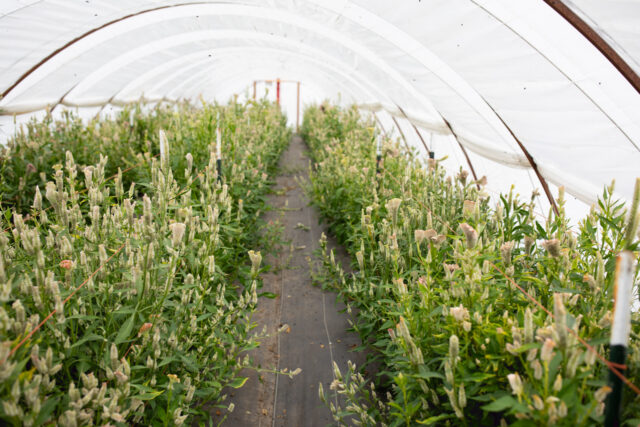 One of my favorite celosias to grow here in the Pacific Northwest is the Supercrest mix because it flowers incredibly early, does well in cooler climates, and has a somewhat compact plant habit. For the last few years I’ve been working on narrowing down the mix into a very soft pastel color range and that is how ‘Pink Chenille’ was born.
One of my favorite celosias to grow here in the Pacific Northwest is the Supercrest mix because it flowers incredibly early, does well in cooler climates, and has a somewhat compact plant habit. For the last few years I’ve been working on narrowing down the mix into a very soft pastel color range and that is how ‘Pink Chenille’ was born.
This mix includes soft pink, pale peach, and champagne. Long, slender stems are topped with a range of wavy, fan-shaped, and spiky textural flower heads. Blooms add a unique, velvety quality to arrangements. Plants have light green foliage and a vigorous branching habit. These colors are perfect for wedding work.

 ‘Coral Reef’ is a special selection that was made from the Supercrest mix that includes a more vivid color range including orange, salmon, peach, raspberry, and marigold. The vigorous plants have a branching habit and are one of the earliest celosias to flower.
‘Coral Reef’ is a special selection that was made from the Supercrest mix that includes a more vivid color range including orange, salmon, peach, raspberry, and marigold. The vigorous plants have a branching habit and are one of the earliest celosias to flower.
This mix is filled with the most unique coral-like blooms—they look as if they belong in the sea.
 The second group I want to highlight from our breeding program are zinnias. What I love most about these flowers is that they are incredibly easy to grow, are the perfect first crop for beginning gardeners, and are reliable, prolific producers no matter where you garden.
The second group I want to highlight from our breeding program are zinnias. What I love most about these flowers is that they are incredibly easy to grow, are the perfect first crop for beginning gardeners, and are reliable, prolific producers no matter where you garden.
 In addition to churning out buckets and buckets of beautiful, long-stemmed blooms that are perfect for cutting, they are well-loved by pollinators.
In addition to churning out buckets and buckets of beautiful, long-stemmed blooms that are perfect for cutting, they are well-loved by pollinators.

 Zinnias are the flowers that kicked off my flower breeding journey and it all started with the discovery of ‘Golden Hour’ back in 2016. This variety is named for the most beautiful time of day—the hour before the sun sets on the horizon.
Zinnias are the flowers that kicked off my flower breeding journey and it all started with the discovery of ‘Golden Hour’ back in 2016. This variety is named for the most beautiful time of day—the hour before the sun sets on the horizon.
Large flowers come in a range of warm honey and cantaloupe shades that look as if they are glowing. As flowers age, the lower petals take on the faintest cranberry edging that beautifully complements their red eyes. This is the first variety bred on the farm and is still my very favorite.

 Another really special large-flowered variety is ‘Alpenglow’, which I discovered many years ago in a long row of ‘Golden Hour’ plants as an off type. I’ve been working to refine its enchanting color range of creamy linen, pale peach, and dusty rose flowers.
Another really special large-flowered variety is ‘Alpenglow’, which I discovered many years ago in a long row of ‘Golden Hour’ plants as an off type. I’ve been working to refine its enchanting color range of creamy linen, pale peach, and dusty rose flowers.
The large pastel blooms sit atop long, strong stems and have an unusual iridescent lavender ring around their striking purple eyes. As flowers age, their petal tips turn a muted rosy pink. This rare color combination gives the blooms an almost opalescent quality.
They pair perfectly with ‘Limelight’ hydrangeas in September. You have to grow it to believe the color!

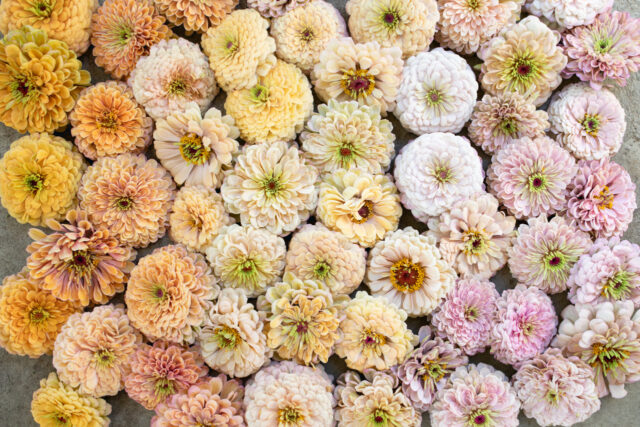 Of all the zinnias that have been born here on the farm, ‘Precious Metals’ might be the most magical. This giant-flowered mix includes shades of linen, icy lavender, pale pink, soft peach, and palomino. As flowers age, the lower petals often fade to turquoise dusted with lavender, giving blooms an icy metallic quality.
Of all the zinnias that have been born here on the farm, ‘Precious Metals’ might be the most magical. This giant-flowered mix includes shades of linen, icy lavender, pale pink, soft peach, and palomino. As flowers age, the lower petals often fade to turquoise dusted with lavender, giving blooms an icy metallic quality.
The flower heads are dense and leathery and the backs of the petals have apple-green veining. To experience their full range of coloring, don’t cut too soon and allow flowers to mature on the plant.

 We offered Unicorn Mix for just one season a number of years ago and people still write in asking when it will be back because they loved it so much. I’m thrilled it’s finally returning!
We offered Unicorn Mix for just one season a number of years ago and people still write in asking when it will be back because they loved it so much. I’m thrilled it’s finally returning!
Medium-sized, domed blooms come in an enchanting range of colors, including raspberry, tangerine, magenta, lemon, apricot, dusty lilac, and blush—all with striking lavender centers.
What makes these flowers so unique is that they have a multitoned ombre effect and many of the blooms possess a rainbow-like quality.
Out of the more than 130 zinnia varieties growing here on the farm, when asked to vote, the team picked Unicorn as their collective favorite, hands down.
To experience their full range of coloring, don’t pick them too soon and allow flowers to mature on the plant.

 As you’re looking at all of the new varieties that we’ll be making available, it could be easy to pass over the ‘Victorian Wedding’ mix because it’s not nearly as showy as some of the others at first glance.
As you’re looking at all of the new varieties that we’ll be making available, it could be easy to pass over the ‘Victorian Wedding’ mix because it’s not nearly as showy as some of the others at first glance.
But when it comes to flower production and the total number of blooms per plant, these babies are absolute workhorses! The stocky plants are so smothered in flowers during the summer months that you can barely see the foliage.
The petite, mostly double blooms come in a highly sought-after color range of buff, pale peach, rose-pink, blush, and the occasional soft orange that is a floral designer’s dream. They remind me of little French macarons and have a very long vase life.

 ‘Little Flower Girl’ was my nickname growing up and I knew that I wanted to pass along the title to a special variety someday. This adorable early-flowering pastel mix features darling miniature flowers in shades of blush, soft pink, pale peach, and champagne.
‘Little Flower Girl’ was my nickname growing up and I knew that I wanted to pass along the title to a special variety someday. This adorable early-flowering pastel mix features darling miniature flowers in shades of blush, soft pink, pale peach, and champagne.
Tall, strong, slender stems carry single, semi-double, and the occasional double blooms that are perfect for arranging, especially when it comes to weddings. They are especially well-loved by pollinators.
 One of the things that I’m most excited about sharing as part of this special seed release is four beautiful mixes that were created in collaboration with my flower breeding friend Kori at Dawn Creek Farm. You can read a wonderful interview with her here.
One of the things that I’m most excited about sharing as part of this special seed release is four beautiful mixes that were created in collaboration with my flower breeding friend Kori at Dawn Creek Farm. You can read a wonderful interview with her here.
 Kori is a flower farmer and plant breeder who has made incredible progress in developing new varieties for the marketplace. We have been working together for the past couple of years on refining these mixes with the intention of helping to get her magical varieties out into the world in a bigger way.
Kori is a flower farmer and plant breeder who has made incredible progress in developing new varieties for the marketplace. We have been working together for the past couple of years on refining these mixes with the intention of helping to get her magical varieties out into the world in a bigger way.
I’m thrilled to have the Dawn Creek beauties as part of our collection!

 Dawn Creek Blush is a beautiful large-flowered pastel mix that produces towering plants that are a sight to behold. Blooms come in a range of soft pink, the palest lavender, and blush, with the occasional ivory and soft peach making an appearance.
Dawn Creek Blush is a beautiful large-flowered pastel mix that produces towering plants that are a sight to behold. Blooms come in a range of soft pink, the palest lavender, and blush, with the occasional ivory and soft peach making an appearance.
Plants have long, strong stems and are incredibly productive. Many of the blooms have a notable cactus-like form and petals are displayed in varying levels of fullness.

 Dawn Creek Peach is a warm, dreamy mix that includes buff, peach, apricot, and faded coral, with the occasional blush. Plants have long, strong stems and are incredibly productive.
Dawn Creek Peach is a warm, dreamy mix that includes buff, peach, apricot, and faded coral, with the occasional blush. Plants have long, strong stems and are incredibly productive.
Many of the flowers have a cactus-like form in a wide range of shapes and sizes, including some with tufted centers. There are so many fun treasures in this collection to be discovered.

 Dawn Creek Honey is a warm, buttery mix that includes a beautiful range of buff, peach, honey, and cream with a subtle gold wash, as well as the occasional dandelion yellow that loves to make an appearance.
Dawn Creek Honey is a warm, buttery mix that includes a beautiful range of buff, peach, honey, and cream with a subtle gold wash, as well as the occasional dandelion yellow that loves to make an appearance.
The large flowers are carried on long, strong stems and many have a cactus-like form, with varying degrees of fullness.
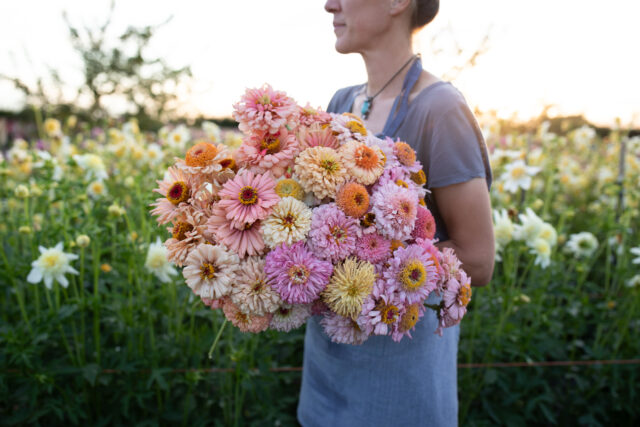
 Here on the farm, there are dozens of different varieties in the works that have come from Kori’s original seeds and the Dawn Creek Pastels mix is a blend of all the different selections that we’ve got cooking.
Here on the farm, there are dozens of different varieties in the works that have come from Kori’s original seeds and the Dawn Creek Pastels mix is a blend of all the different selections that we’ve got cooking.
Large flowers come in a muted rainbow of colors, including coral, peach, apricot, strawberry, pink, blush, buff, and gold, plus a few other surprises.
Many of the blooms will have a cactus-like form with varying degrees of fullness, while others may exhibit tufted or domed centers. This mix has so many unique treasures to discover.
 The last group of plants that we’ve been working on as part of this special breeding variety release are dahlia seed mixes. We’ve been able to create four unique mixes that produce flowers in a relatively distinct range of flower forms by collecting seed from separate fields.
The last group of plants that we’ve been working on as part of this special breeding variety release are dahlia seed mixes. We’ve been able to create four unique mixes that produce flowers in a relatively distinct range of flower forms by collecting seed from separate fields.

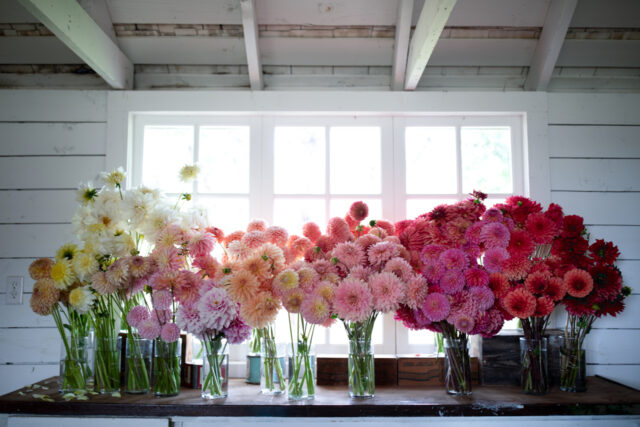 One of the most exciting and surprising discoveries I made early on my dahlia-growing journey was learning how new varieties were created. Unlike tubers or cuttings, which produce an exact clone of the plant they come from, dahlias grown from seed offer a treasure trove of new possibilities, each one something that’s never existed before. If you discover a variety you love, tubers can be saved and planted out the following year—and you even get to name them!
One of the most exciting and surprising discoveries I made early on my dahlia-growing journey was learning how new varieties were created. Unlike tubers or cuttings, which produce an exact clone of the plant they come from, dahlias grown from seed offer a treasure trove of new possibilities, each one something that’s never existed before. If you discover a variety you love, tubers can be saved and planted out the following year—and you even get to name them!
 In my experience, anemone-flowered dahlias are stingy seed producers so every one of the seeds in this mix is a tiny treasure. We collected these ‘Cancan Girls’ seeds from a breeding field of anemone types and so far about 70% of the plants grown from this seed produce anemone-flowered blooms.
In my experience, anemone-flowered dahlias are stingy seed producers so every one of the seeds in this mix is a tiny treasure. We collected these ‘Cancan Girls’ seeds from a breeding field of anemone types and so far about 70% of the plants grown from this seed produce anemone-flowered blooms.
 This dahlia seed mix is filled with a dazzling rainbow of tufted blooms in all shapes and sizes. The rich color range includes reds, maroons, pinks, purples, and many bicolors—no two plants will be the same! If you love this form, ‘Cancan Girls’ is a must grow. We probably won’t offer it again in the future because it is so labor-intensive to produce, so be sure to get the seeds while you can.
This dahlia seed mix is filled with a dazzling rainbow of tufted blooms in all shapes and sizes. The rich color range includes reds, maroons, pinks, purples, and many bicolors—no two plants will be the same! If you love this form, ‘Cancan Girls’ is a must grow. We probably won’t offer it again in the future because it is so labor-intensive to produce, so be sure to get the seeds while you can.
 ‘Floret’ (what started as C33) is one of the first dahlias I bred here on the farm. The flowers are a strange fusion between collarette and anemone forms. Blooms start out candy pink and fade to warm peach with an iridescent lavender wash as they age.
‘Floret’ (what started as C33) is one of the first dahlias I bred here on the farm. The flowers are a strange fusion between collarette and anemone forms. Blooms start out candy pink and fade to warm peach with an iridescent lavender wash as they age.
But what I love most about ‘Floret’ is that of all the dahlia varieties I’ve ever collected seed from, nearly all her offspring possess similar characteristics to their mother, including her unique form and soft, unusual coloring. I’ve never grown seed from a dahlia variety with such a high percentage of “keepers.”

 Seed from the ‘Petite Florets’ mix was collected from ‘Floret’ and is a range of pastel tones, including peach, apricot, dusty rose, lavender, sunbleached raspberry, and buttercream, all with a hauntingly beautiful iridescent wash.
Seed from the ‘Petite Florets’ mix was collected from ‘Floret’ and is a range of pastel tones, including peach, apricot, dusty rose, lavender, sunbleached raspberry, and buttercream, all with a hauntingly beautiful iridescent wash.
A large percentage of the blooms are either collaretes or anemones, many of which have snipped petal tips, long feathery ruffles, and twizzly eyelashes encircling their fuzzy centers. Every one of them is pure magic!

 Another beautiful new mix is ‘Shooting Stars’, which was collected from an entire field of collarettes and features an incredible range of star-shaped flowers, including singles, collarettes, orchettes, orchids, and other fun surprises—no two plants will be the same!
Another beautiful new mix is ‘Shooting Stars’, which was collected from an entire field of collarettes and features an incredible range of star-shaped flowers, including singles, collarettes, orchettes, orchids, and other fun surprises—no two plants will be the same!
You’ll find flowers with snipped edges, rolled petals, stripes, streaks, and speckles in every color of the rainbow. The bees love this mix and it’d be worth planting just for the pollinators.

 Last but not least is ‘Bee’s Choice’—one of the most popular seed mixes we’ve ever offered. This year’s mix was collected from all of our different dahlia breeding patches on the farm and includes a wide range of shapes, sizes, and colors!
Last but not least is ‘Bee’s Choice’—one of the most popular seed mixes we’ve ever offered. This year’s mix was collected from all of our different dahlia breeding patches on the farm and includes a wide range of shapes, sizes, and colors!
Most of the flowers will have open centers, which will attract lots of pollinators to your garden but you should also get some fun surprises in the mix including some balls, informal decoratives, and maybe an anemone or two.
 If you’ve made it to the end of this post, a huge thank you for taking the time to meet all of the Floret Originals and letting me share my overwhelming excitement about them with you.
If you’ve made it to the end of this post, a huge thank you for taking the time to meet all of the Floret Originals and letting me share my overwhelming excitement about them with you.
To celebrate the release of these special seeds we’re hosting a giveaway of 10 deluxe seed collections. Each collection includes all of the new varieties (26 packets!) and a beautiful growing guide. For a chance to win, please leave a comment below sharing what breeding varieties you’re most excited to add to your garden this season. Winners will be announced on February 5. Please note: Because we can’t yet send the breeding varieties internationally, this giveaway is open to U.S. and Canadian residents only.
Update: A huge congratulations to our winners: Angela, Katelyn Lacey, Tai Quirke, Chris, Leah, Stephanie Peoples, Autumn Mulverhill, Andrea K., Anne-Sophie and Ruth Goethals.
Please note: If your comment doesn’t show up right away, sit tight; we have a spam filter that requires us to approve comments before they are published.
 کاغذ و یادداشت های پس از آن
کاغذ و یادداشت های پس از آن خودکار
خودکار سایر لوازم
سایر لوازم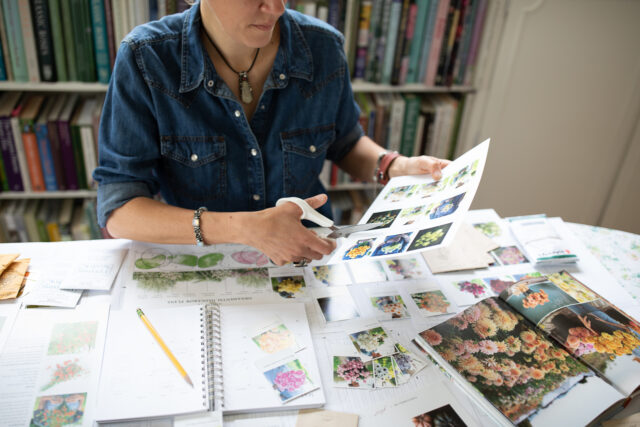 لوازم اداری اولیه
لوازم اداری اولیه


 I’ve had the privilege of knowing Ariella since the beginning of my career and she has had such a significant impact on my flower journey. I remember the first time I wrote to her, I was just getting my start as a writer and wanted to interview her for a tiny little farming publication with an even smaller readership base.
I’ve had the privilege of knowing Ariella since the beginning of my career and she has had such a significant impact on my flower journey. I remember the first time I wrote to her, I was just getting my start as a writer and wanted to interview her for a tiny little farming publication with an even smaller readership base. 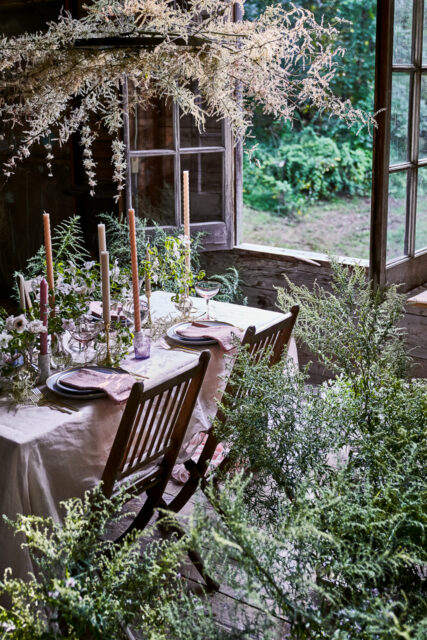 I’m so curious to know what inspired you to write
I’m so curious to know what inspired you to write  What was the process like for creating the arrangements and installations that grace the pages of your beautiful book? Would you take us on a day in the life of one of your big shoots, from gathering the flowers to creating the arrangements to styling, lighting, and making the photographs? Oh to be a fly on the wall!
What was the process like for creating the arrangements and installations that grace the pages of your beautiful book? Would you take us on a day in the life of one of your big shoots, from gathering the flowers to creating the arrangements to styling, lighting, and making the photographs? Oh to be a fly on the wall!  Creating a book is such a huge endeavor—so many details to coordinate and so many variables to maneuver, all while working against a strict set of deadlines. I’m amazed by how much traveling must have been involved in shooting
Creating a book is such a huge endeavor—so many details to coordinate and so many variables to maneuver, all while working against a strict set of deadlines. I’m amazed by how much traveling must have been involved in shooting 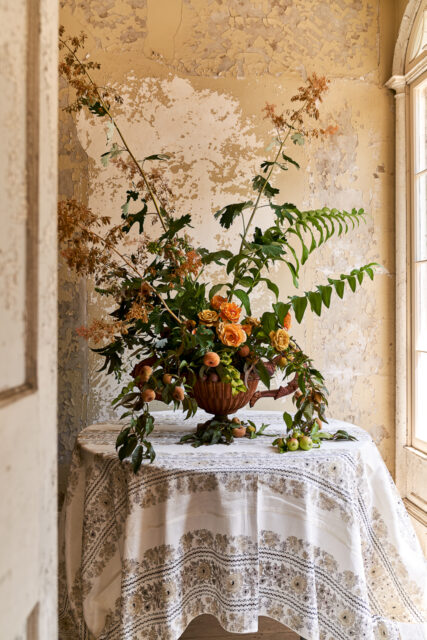 This book provides a window into the most beautiful, elegant homes and spaces. The architecture and colors of the interiors paired with your exquisite flowers are almost too much to handle! Can you tell me a little about these special spaces and how you chose them?
This book provides a window into the most beautiful, elegant homes and spaces. The architecture and colors of the interiors paired with your exquisite flowers are almost too much to handle! Can you tell me a little about these special spaces and how you chose them? You have a very deep and powerful relationship with nature. How has it influenced your personal approach to floral design?
You have a very deep and powerful relationship with nature. How has it influenced your personal approach to floral design? In your new book, you explore a much wilder side of nature than I have seen you do before. You say, “With each chapter, I stray just a little bit further into the meadow…” There’s something so magical about how you embrace weeds and brambles and elevate them in such an unexpected way. Can you talk a little about how your relationship with the “rough and tumble,” as you put it, has evolved over the years?
In your new book, you explore a much wilder side of nature than I have seen you do before. You say, “With each chapter, I stray just a little bit further into the meadow…” There’s something so magical about how you embrace weeds and brambles and elevate them in such an unexpected way. Can you talk a little about how your relationship with the “rough and tumble,” as you put it, has evolved over the years? One of the things that has always struck me about your work is that it has such a strong sense of place. Your arrangements always look as if they are extensions of their surroundings and it’s hard to tell where they leave off and the rest of the space begins. When creating a bouquet or a floral installation, what are the important things to consider if one wants it to belong to its surroundings?
One of the things that has always struck me about your work is that it has such a strong sense of place. Your arrangements always look as if they are extensions of their surroundings and it’s hard to tell where they leave off and the rest of the space begins. When creating a bouquet or a floral installation, what are the important things to consider if one wants it to belong to its surroundings? Color can be one of the most challenging aspects of floral design to master and so many of us struggle to have our arrangements look the way we want them to. Can you share any advice on working with color and how you personally approach it?
Color can be one of the most challenging aspects of floral design to master and so many of us struggle to have our arrangements look the way we want them to. Can you share any advice on working with color and how you personally approach it?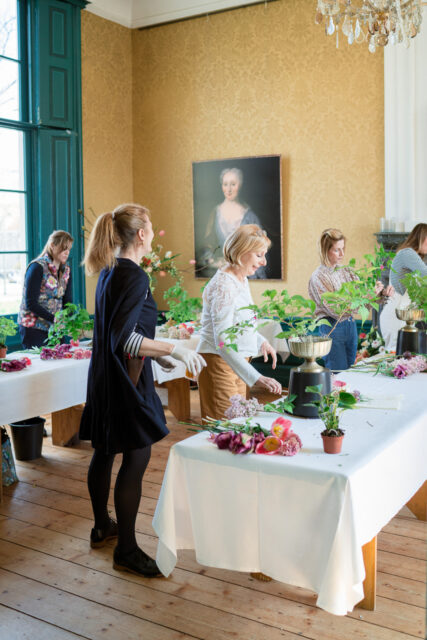 You have had such an incredible career, lived and worked on both coasts, traveled the world, taught in the most exotic places, and decorated hundreds if not thousands of weddings and events over the past 30 years. Looking back, is there a favorite chapter or experience that has left its mark on you?
You have had such an incredible career, lived and worked on both coasts, traveled the world, taught in the most exotic places, and decorated hundreds if not thousands of weddings and events over the past 30 years. Looking back, is there a favorite chapter or experience that has left its mark on you?  With each book that I’ve written, I’ve had an intention and hope for the reader. I’m curious to know if you feel the same way. What do you hope that readers will take away from this beautiful book? What is it that you want to linger with them after they’ve turned the last page?
With each book that I’ve written, I’ve had an intention and hope for the reader. I’m curious to know if you feel the same way. What do you hope that readers will take away from this beautiful book? What is it that you want to linger with them after they’ve turned the last page?  Now that this beautiful book is out in the world, what are your plans for the coming season? Will you be hosting any workshops or making any exciting journeys? I’d love to hear what you have planned next.
Now that this beautiful book is out in the world, what are your plans for the coming season? Will you be hosting any workshops or making any exciting journeys? I’d love to hear what you have planned next.  Ariella, thank you so much for taking the time to share about your incredible book—it’s a gift to the world.
Ariella, thank you so much for taking the time to share about your incredible book—it’s a gift to the world.  To celebrate the release of Ariella’s new book, Home in Bloom, we’re giving away five copies. For a chance to win, please share one of your favorite unexpected or wilder bouquet ingredients. If you don’t have one, tell us what about this interview inspired you the most. Winners will be announced on March 12. Please note: This giveaway is open to U.S. and Canadian residents only.
To celebrate the release of Ariella’s new book, Home in Bloom, we’re giving away five copies. For a chance to win, please share one of your favorite unexpected or wilder bouquet ingredients. If you don’t have one, tell us what about this interview inspired you the most. Winners will be announced on March 12. Please note: This giveaway is open to U.S. and Canadian residents only.
 Over the next few years, we swapped seeds, shared photos, compared notes, and talked over Zoom—cheering each other in our efforts. Breeding is typically a very isolated, solitary endeavor, and finding a kindred spirit was such a gift.
Over the next few years, we swapped seeds, shared photos, compared notes, and talked over Zoom—cheering each other in our efforts. Breeding is typically a very isolated, solitary endeavor, and finding a kindred spirit was such a gift.  Kori, I’m so happy you’re here! I’ve been waiting for the day that we could finally meet in person. For those who aren’t familiar with your work, could you
Kori, I’m so happy you’re here! I’ve been waiting for the day that we could finally meet in person. For those who aren’t familiar with your work, could you  My art degree was actually devoted to oil painting, and it was interesting and challenging to attempt to pursue my deep love of plants, horticulture, and creative arts in tandem in the university setting, which in my personal experience at the time maintained a palpable underlying cultural and intellectual divide between the arts and the sciences.
My art degree was actually devoted to oil painting, and it was interesting and challenging to attempt to pursue my deep love of plants, horticulture, and creative arts in tandem in the university setting, which in my personal experience at the time maintained a palpable underlying cultural and intellectual divide between the arts and the sciences.  After college I worked growing vegetables and herbs on a local ranch, and began a textile and natural dye business on the side, spinning, weaving, and growing plants to discover their hidden colors. This evolved into a small online seed company, selling seeds gathered from the wide range of dye plants growing in my garden, along with a blog sharing instructions for growing, harvesting, use, and seed saving.
After college I worked growing vegetables and herbs on a local ranch, and began a textile and natural dye business on the side, spinning, weaving, and growing plants to discover their hidden colors. This evolved into a small online seed company, selling seeds gathered from the wide range of dye plants growing in my garden, along with a blog sharing instructions for growing, harvesting, use, and seed saving.  Toby and I got married in 2014, at which point my mom and I grew all the flowers for the wedding. This was the first time I included a large amount of flowers into a crop plan specifically for cutting, which was quite exciting. Soon after, we had the opportunity to purchase land ourselves in Rio Linda, California (just north of Sacramento). I left my ranch job, and we moved and began Dawn Creek Farm.
Toby and I got married in 2014, at which point my mom and I grew all the flowers for the wedding. This was the first time I included a large amount of flowers into a crop plan specifically for cutting, which was quite exciting. Soon after, we had the opportunity to purchase land ourselves in Rio Linda, California (just north of Sacramento). I left my ranch job, and we moved and began Dawn Creek Farm.  You are located in Santa Cruz, California. What is your growing season like? Can you describe your garden space?
You are located in Santa Cruz, California. What is your growing season like? Can you describe your garden space? 
 In late June, we planted our chrysanthemums in what had been the original zinnia field, and soon after discovered several volunteer zinnia seedlings coming up in the rows. I left them to bloom, hoping maybe, just maybe, something magical would happen … and it did.
In late June, we planted our chrysanthemums in what had been the original zinnia field, and soon after discovered several volunteer zinnia seedlings coming up in the rows. I left them to bloom, hoping maybe, just maybe, something magical would happen … and it did.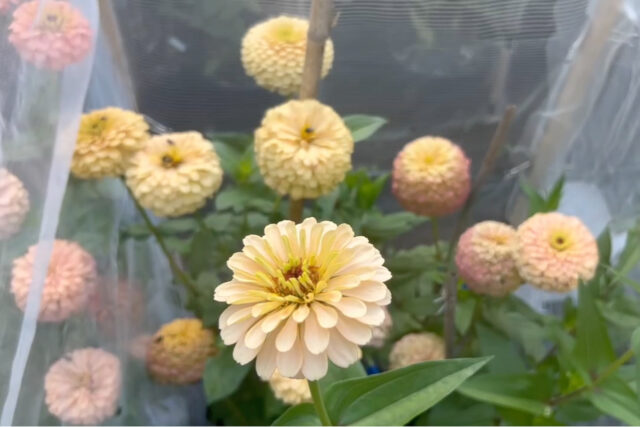
 You are breeding and selecting many varieties of flowers, but your main focus is zinnias. What do you love most about this particular flower?
You are breeding and selecting many varieties of flowers, but your main focus is zinnias. What do you love most about this particular flower?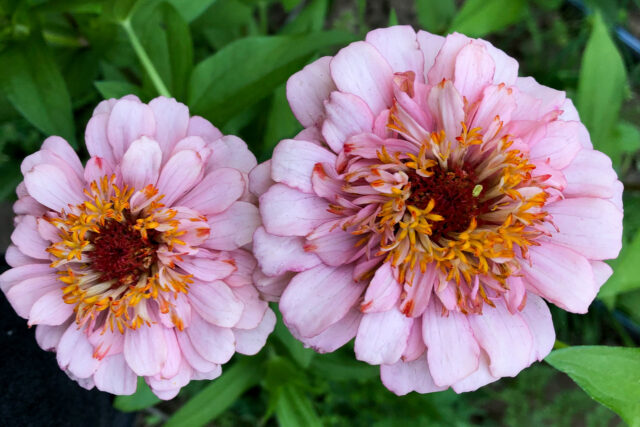 The seed lineages I have been working with have also always very clearly communicated to me when and how they are ready to share their magic with the wider world, and my decisions to share seed from this evolving relationship have always culminated in response to this. When I became critically ill with a soil-borne illness in 2020 and our family and farm were forced to change course and relocate away from the source of my illness, my relationship with these seeds and the process of sharing them with other gardeners and inviting in community support through our first fundraiser carried our small family through the most intense and challenging years and uncertainties of my life, and ultimately allowed me to continue my work with seeds.
The seed lineages I have been working with have also always very clearly communicated to me when and how they are ready to share their magic with the wider world, and my decisions to share seed from this evolving relationship have always culminated in response to this. When I became critically ill with a soil-borne illness in 2020 and our family and farm were forced to change course and relocate away from the source of my illness, my relationship with these seeds and the process of sharing them with other gardeners and inviting in community support through our first fundraiser carried our small family through the most intense and challenging years and uncertainties of my life, and ultimately allowed me to continue my work with seeds. Tell us a bit about your breeding efforts. What’s the process? Technically, how do you do it?
Tell us a bit about your breeding efforts. What’s the process? Technically, how do you do it?  I approach developing varieties of outcrossing species from many angles depending on the individuals at hand, from carefully controlled hand-pollinated crosses to larger collective winnowing of traits. I am committed to maintaining as much genetic diversity within a population as possible while honing in on cohesive colors, forms, vigor, and productivity within a population. The exact step-by-step how-to honestly feels like too much for me to distill down in the context of this interview (and again I will point to Tiffany’s book as she has a knack for explaining the essence of things in a very accessible way!), but I think of my own process in terms of three stages:
I approach developing varieties of outcrossing species from many angles depending on the individuals at hand, from carefully controlled hand-pollinated crosses to larger collective winnowing of traits. I am committed to maintaining as much genetic diversity within a population as possible while honing in on cohesive colors, forms, vigor, and productivity within a population. The exact step-by-step how-to honestly feels like too much for me to distill down in the context of this interview (and again I will point to Tiffany’s book as she has a knack for explaining the essence of things in a very accessible way!), but I think of my own process in terms of three stages:
 What do you hope a person experiences when they look at and hold the flowers that you have bred? What is your hope for their future?
What do you hope a person experiences when they look at and hold the flowers that you have bred? What is your hope for their future?
 Do you have any other exciting projects in the works?
Do you have any other exciting projects in the works? What is the best way for someone to place an order? Do you have particular growers that offer your varieties?
What is the best way for someone to place an order? Do you have particular growers that offer your varieties? Seeds: Floret is the only seed company that we have officially partnered with to sell our seeds at this time, and many who have followed our journey will be happy to know that a generous portion of every single sale of these seeds comes directly back to supporting our farm’s continued work. I have gotten inquiries from others who are interested in offering our seeds for sale, and I’m looking forward to making guidelines available for those who are interested in saving and selling our seeds consciously on a smaller scale to do so.
Seeds: Floret is the only seed company that we have officially partnered with to sell our seeds at this time, and many who have followed our journey will be happy to know that a generous portion of every single sale of these seeds comes directly back to supporting our farm’s continued work. I have gotten inquiries from others who are interested in offering our seeds for sale, and I’m looking forward to making guidelines available for those who are interested in saving and selling our seeds consciously on a smaller scale to do so.  Do you have any upcoming important dates for shop launches, fundraisers, catalogs, or anything else people should know about? Also, where do you ship your seeds?
Do you have any upcoming important dates for shop launches, fundraisers, catalogs, or anything else people should know about? Also, where do you ship your seeds?  To celebrate the upcoming release of the Dawn Creek varieties, we’re giving away 10 seed bundles. Each bundle will contain a packet of each of Kori’s mixes: Dawn Creek Blush, Dawn Creek Honey, Dawn Creek Pastels, and Dawn Creek Peach.
To celebrate the upcoming release of the Dawn Creek varieties, we’re giving away 10 seed bundles. Each bundle will contain a packet of each of Kori’s mixes: Dawn Creek Blush, Dawn Creek Honey, Dawn Creek Pastels, and Dawn Creek Peach. 
 I thought now would be a great time to introduce you to these magical little plant souls and share a bit more about what makes them so special. Each variety has a unique personality and while at first glance some might look a bit similar, they are all quite different when you get to know them.
I thought now would be a great time to introduce you to these magical little plant souls and share a bit more about what makes them so special. Each variety has a unique personality and while at first glance some might look a bit similar, they are all quite different when you get to know them.  I’ve organized this post into three main sections. First, we’ll explore the 12 celosia varieties that we’re offering, then deep dive into zinnias (we have 10 beautiful mixes!), and end with dahlias which I know so many people are excited about.
I’ve organized this post into three main sections. First, we’ll explore the 12 celosia varieties that we’re offering, then deep dive into zinnias (we have 10 beautiful mixes!), and end with dahlias which I know so many people are excited about. The first group of plants that I want to share with you is
The first group of plants that I want to share with you is  However, if you’re growing flowers to arrange with, these heat lovers are an indispensable addition to your cutting garden and have your back when it comes to churning out bouquet ingredients.
However, if you’re growing flowers to arrange with, these heat lovers are an indispensable addition to your cutting garden and have your back when it comes to churning out bouquet ingredients. 
 ‘
‘
 ‘
‘
 ‘
‘
 If you’re only looking at the plumes cut from the plant, one might think that ‘
If you’re only looking at the plumes cut from the plant, one might think that ‘
 Next up is ‘
Next up is ‘
 A few years back, Eric (our seed specialist) started experimenting with trying to isolate the most textural, feathery plumes in the ‘Summer Sherbet’ mix, and create a narrower, more vivid color range, and that’s how ‘
A few years back, Eric (our seed specialist) started experimenting with trying to isolate the most textural, feathery plumes in the ‘Summer Sherbet’ mix, and create a narrower, more vivid color range, and that’s how ‘
 In the early days, ‘Summer Sherbet’ was a much broader range of colors which included some yellows and greens. I had always wanted to tease the fresh, clean green out of this variety and finally succeeded with ‘
In the early days, ‘Summer Sherbet’ was a much broader range of colors which included some yellows and greens. I had always wanted to tease the fresh, clean green out of this variety and finally succeeded with ‘
 ‘
‘
 While I tend to be most often drawn to soft pastel colors, there’s always a place for richer, more vibrant tones, too.
While I tend to be most often drawn to soft pastel colors, there’s always a place for richer, more vibrant tones, too. 
 The early-flowering variety ‘
The early-flowering variety ‘
 One of my favorite celosias to grow here in the Pacific Northwest is the Supercrest mix because it flowers incredibly early, does well in cooler climates, and has a somewhat compact plant habit. For the last few years I’ve been working on narrowing down the mix into a very soft pastel color range and that is how ‘
One of my favorite celosias to grow here in the Pacific Northwest is the Supercrest mix because it flowers incredibly early, does well in cooler climates, and has a somewhat compact plant habit. For the last few years I’ve been working on narrowing down the mix into a very soft pastel color range and that is how ‘
 ‘
‘ The second group I want to highlight from our breeding program are
The second group I want to highlight from our breeding program are  In addition to churning out buckets and buckets of beautiful, long-stemmed blooms that are perfect for cutting, they are well-loved by pollinators.
In addition to churning out buckets and buckets of beautiful, long-stemmed blooms that are perfect for cutting, they are well-loved by pollinators. 
 Zinnias are the flowers that kicked off my flower breeding journey and it all started with the discovery of ‘
Zinnias are the flowers that kicked off my flower breeding journey and it all started with the discovery of ‘
 Another really special large-flowered variety is ‘
Another really special large-flowered variety is ‘
 Of all the zinnias that have been born here on the farm, ‘
Of all the zinnias that have been born here on the farm, ‘
 We offered
We offered 
 As you’re looking at all of the new varieties that we’ll be making available, it could be easy to pass over the ‘
As you’re looking at all of the new varieties that we’ll be making available, it could be easy to pass over the ‘
 ‘
‘ One of the things that I’m most excited about sharing as part of this special seed release is four beautiful mixes that were created in collaboration with my flower breeding friend Kori at
One of the things that I’m most excited about sharing as part of this special seed release is four beautiful mixes that were created in collaboration with my flower breeding friend Kori at  Kori is a flower farmer and plant breeder who has made incredible progress in developing new varieties for the marketplace. We have been working together for the past couple of years on refining these mixes with the intention of helping to get her magical varieties out into the world in a bigger way.
Kori is a flower farmer and plant breeder who has made incredible progress in developing new varieties for the marketplace. We have been working together for the past couple of years on refining these mixes with the intention of helping to get her magical varieties out into the world in a bigger way. 






 Here on the farm, there are dozens of different varieties in the works that have come from Kori’s original seeds and the
Here on the farm, there are dozens of different varieties in the works that have come from Kori’s original seeds and the  The last group of plants that we’ve been working on as part of this special breeding variety release are dahlia seed mixes. We’ve been able to create four unique mixes that produce flowers in a relatively distinct range of flower forms by collecting seed from separate fields.
The last group of plants that we’ve been working on as part of this special breeding variety release are dahlia seed mixes. We’ve been able to create four unique mixes that produce flowers in a relatively distinct range of flower forms by collecting seed from separate fields. 
 One of the most exciting and surprising discoveries I made early on my dahlia-growing journey was learning how new varieties were created. Unlike tubers or cuttings, which produce an exact clone of the plant they come from, dahlias grown from seed offer a treasure trove of new possibilities, each one something that’s never existed before.
One of the most exciting and surprising discoveries I made early on my dahlia-growing journey was learning how new varieties were created. Unlike tubers or cuttings, which produce an exact clone of the plant they come from, dahlias grown from seed offer a treasure trove of new possibilities, each one something that’s never existed before.  In my experience, anemone-flowered dahlias are stingy seed producers so every one of the seeds in this mix is a tiny treasure. We collected these ‘
In my experience, anemone-flowered dahlias are stingy seed producers so every one of the seeds in this mix is a tiny treasure. We collected these ‘ This dahlia seed mix i
This dahlia seed mix i ‘Floret’ (what started as C33) is one of the first dahlias I bred here on the farm. The flowers are a strange fusion between collarette and anemone forms. Blooms start out candy pink and fade to warm peach with an iridescent lavender wash as they age.
‘Floret’ (what started as C33) is one of the first dahlias I bred here on the farm. The flowers are a strange fusion between collarette and anemone forms. Blooms start out candy pink and fade to warm peach with an iridescent lavender wash as they age. 
 Seed from the ‘Petite Florets’ mix was collected from ‘Floret’ and is a range of pastel tones, including peach, apricot, dusty rose, lavender, sunbleached raspberry, and buttercream, all with a hauntingly beautiful iridescent wash.
Seed from the ‘Petite Florets’ mix was collected from ‘Floret’ and is a range of pastel tones, including peach, apricot, dusty rose, lavender, sunbleached raspberry, and buttercream, all with a hauntingly beautiful iridescent wash. 
 Another beautiful new mix is ‘
Another beautiful new mix is ‘
 Last but not least is ‘
Last but not least is ‘ If you’ve made it to the end of this post, a huge thank you for taking the time to meet all of the Floret Originals and letting me share my overwhelming excitement about them with you.
If you’ve made it to the end of this post, a huge thank you for taking the time to meet all of the Floret Originals and letting me share my overwhelming excitement about them with you. 
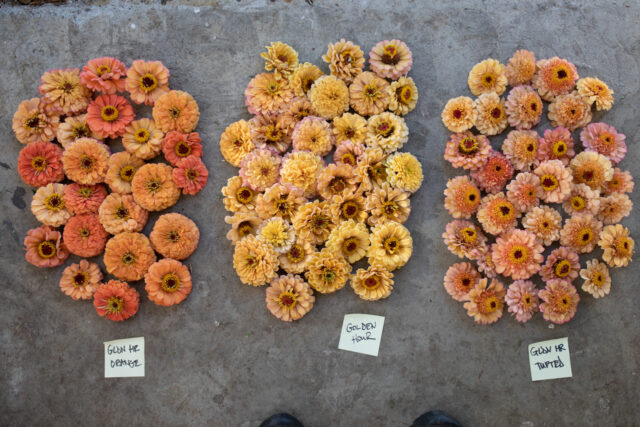 I’m confused. What exactly is a Floret Original? How are they different from the varieties you’ve carried in the past?
I’m confused. What exactly is a Floret Original? How are they different from the varieties you’ve carried in the past? Are you going to offer any other seed besides the Floret Originals in the future? Where can I find cress or sweet peas? Help!
Are you going to offer any other seed besides the Floret Originals in the future? Where can I find cress or sweet peas? Help! My farm is small and every square foot counts. What percentage of the plants will come back true to the photos on your site?
My farm is small and every square foot counts. What percentage of the plants will come back true to the photos on your site?  Can I grow out and resell the seed from Floret Originals or Dawn Creek seed varieties?
Can I grow out and resell the seed from Floret Originals or Dawn Creek seed varieties? Why do the Floret Original varieties cost more than other seeds?
Why do the Floret Original varieties cost more than other seeds? I’m trying to find information about flower seed saving, and I can’t find anything. Can you point me in the right direction?
I’m trying to find information about flower seed saving, and I can’t find anything. Can you point me in the right direction? How many seeds come in each packet?
How many seeds come in each packet? Are your seeds certified organic?
Are your seeds certified organic? Do you have any tips for growing the new breeding varieties? Each seed is so precious and I want to make sure I do everything right!
Do you have any tips for growing the new breeding varieties? Each seed is so precious and I want to make sure I do everything right! Can I grow celosia, dahlias, and zinnias in pots?
Can I grow celosia, dahlias, and zinnias in pots? If things sell out, will you be restocking? What does it mean when a variety says “Sold Out” or “Coming Soon”?
If things sell out, will you be restocking? What does it mean when a variety says “Sold Out” or “Coming Soon”?  Can you send seed for the Floret Original varieties internationally?
Can you send seed for the Floret Original varieties internationally? 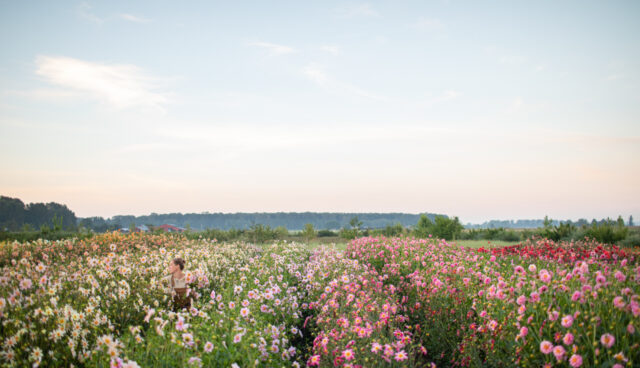 Will items in my cart be held for me?
Will items in my cart be held for me?  Can I change my order?
Can I change my order? When will my order ship?
When will my order ship? How should I store my seeds if I don’t want to plant them all right away?
How should I store my seeds if I don’t want to plant them all right away? If you have questions that haven’t been answered above, please leave a comment below.
If you have questions that haven’t been answered above, please leave a comment below. 
 بسیاری از باغبانان در مناطق گرمتر جهان میتوانند با موفقیت دانههای زینیا را مستقیماً به باغ هدایت کنند، اما در اینجا در واشنگتن خنک، ما گیاهان خود را در اوایل گلخانه، 4 تا 6 هفته قبل از آخرین یخبندان بهاری خود شروع میکنیم.
بسیاری از باغبانان در مناطق گرمتر جهان میتوانند با موفقیت دانههای زینیا را مستقیماً به باغ هدایت کنند، اما در اینجا در واشنگتن خنک، ما گیاهان خود را در اوایل گلخانه، 4 تا 6 هفته قبل از آخرین یخبندان بهاری خود شروع میکنیم.  پس از اینکه هوا به اندازه کافی گرم شد و تمام خطر یخبندان از بین رفت، گیاهان را در مزرعه قرار می دهند.
پس از اینکه هوا به اندازه کافی گرم شد و تمام خطر یخبندان از بین رفت، گیاهان را در مزرعه قرار می دهند. مانند هر گلی که در مزرعه ما رشد می کند، ما سعی می کنیم بهترین شروع ممکن را به آنها بدهیم و بستر کاشت خود را با دوز سخاوتمندانه کمپوست و کود آلی آماده کنیم.
مانند هر گلی که در مزرعه ما رشد می کند، ما سعی می کنیم بهترین شروع ممکن را به آنها بدهیم و بستر کاشت خود را با دوز سخاوتمندانه کمپوست و کود آلی آماده کنیم.  پس از آماده شدن بسترهای کاشت، خطوط آبیاری قطره ای را می گذاریم و سپس با لایه ای از پارچه منظره از پیش سوخته روی تخت ها را می پوشانیم. استفاده از پارچه برای موفقیت لازم نیست، اما در اینجا در مزرعه از آن برای افزایش حرارت و سرکوب علف های هرز استفاده می کنیم.
پس از آماده شدن بسترهای کاشت، خطوط آبیاری قطره ای را می گذاریم و سپس با لایه ای از پارچه منظره از پیش سوخته روی تخت ها را می پوشانیم. استفاده از پارچه برای موفقیت لازم نیست، اما در اینجا در مزرعه از آن برای افزایش حرارت و سرکوب علف های هرز استفاده می کنیم. گیاهان به فاصله 9 تا 12 اینچ (23 تا 30 سانتی متر) از هم قرار می گیرند و بسته به آب و هوا یک تا دو بار در هفته به صورت عمیق آبیاری می شوند. اگر خاک خوب و منبع ثابت آب داده شود، گیاهان می توانند بزرگ شوند و به نوعی حمایت نیاز دارند.
گیاهان به فاصله 9 تا 12 اینچ (23 تا 30 سانتی متر) از هم قرار می گیرند و بسته به آب و هوا یک تا دو بار در هفته به صورت عمیق آبیاری می شوند. اگر خاک خوب و منبع ثابت آب داده شود، گیاهان می توانند بزرگ شوند و به نوعی حمایت نیاز دارند.  اگر در ردیفهای بلند رشد کنید، میتوان گیاهان را با کوبیدن پایههای سنگین یا تیرهای T در اطراف محیط بستر و با استفاده از ریسمان نگهدارنده برای ایجاد جعبهای با رشتههای رشتهای برای نگه داشتن گیاهان در حالت قائم جمع کرد. اگر زینیا را در تخت باغچه خود پرورش می دهید، گیاهان جداگانه را می توان با ریسمان به ستون ها گره زد.
اگر در ردیفهای بلند رشد کنید، میتوان گیاهان را با کوبیدن پایههای سنگین یا تیرهای T در اطراف محیط بستر و با استفاده از ریسمان نگهدارنده برای ایجاد جعبهای با رشتههای رشتهای برای نگه داشتن گیاهان در حالت قائم جمع کرد. اگر زینیا را در تخت باغچه خود پرورش می دهید، گیاهان جداگانه را می توان با ریسمان به ستون ها گره زد.  راز بدست آوردن فراوان ترین گل و طولانی ترین ساقه ها از زینیاها نیشگون گرفتن آنها در جوانی است. زمانی که گیاهان 8 تا 12 اینچ (20 تا 30 سانتیمتر) ارتفاع دارند، هرسهای تیز بردارید و قسمت بالایی آن را به اندازه 3 تا 4 اینچ (7 تا 10 سانتیمتر) از روی گیاه، درست بالای مجموعهای از برگها جدا کنید. این به گیاه سیگنال می دهد که چندین ساقه را از زیر جایی که برش ایجاد شده است بفرستد.
راز بدست آوردن فراوان ترین گل و طولانی ترین ساقه ها از زینیاها نیشگون گرفتن آنها در جوانی است. زمانی که گیاهان 8 تا 12 اینچ (20 تا 30 سانتیمتر) ارتفاع دارند، هرسهای تیز بردارید و قسمت بالایی آن را به اندازه 3 تا 4 اینچ (7 تا 10 سانتیمتر) از روی گیاه، درست بالای مجموعهای از برگها جدا کنید. این به گیاه سیگنال می دهد که چندین ساقه را از زیر جایی که برش ایجاد شده است بفرستد.  در طول دوره های هوای گرم و خشک، زینیا مستعد ابتلا به کپک پودری است. ایجاد جریان هوای خوب در اطراف گیاهان و اطمینان از اینکه آنها تحت هیچ گونه تنش خشکی قرار نمی گیرند، به به حداقل رساندن فشار بیماری کمک می کند.
در طول دوره های هوای گرم و خشک، زینیا مستعد ابتلا به کپک پودری است. ایجاد جریان هوای خوب در اطراف گیاهان و اطمینان از اینکه آنها تحت هیچ گونه تنش خشکی قرار نمی گیرند، به به حداقل رساندن فشار بیماری کمک می کند.  زینیاها باید زمانی چیده شوند که کاملا رسیده باشند وگرنه در گلدان ماندگار نمی شوند. برای اینکه بفهمید یک زنیا برای برداشت آماده است یا خیر، از “تست تکان دادن” استفاده کنید. به سادگی ساقه را حدود 8 اینچ (20 سانتی متر) از سر گل به سمت پایین بگیرید و به آرامی آن را تکان دهید. اگر ساقه آویزان یا خم شده باشد، آماده بریدن نیست. اگر ساقه سفت باشد و صاف بماند، آماده برداشت است.
زینیاها باید زمانی چیده شوند که کاملا رسیده باشند وگرنه در گلدان ماندگار نمی شوند. برای اینکه بفهمید یک زنیا برای برداشت آماده است یا خیر، از “تست تکان دادن” استفاده کنید. به سادگی ساقه را حدود 8 اینچ (20 سانتی متر) از سر گل به سمت پایین بگیرید و به آرامی آن را تکان دهید. اگر ساقه آویزان یا خم شده باشد، آماده بریدن نیست. اگر ساقه سفت باشد و صاف بماند، آماده برداشت است.  زینیا یک گل “کثیف” در نظر گرفته می شود و از یک یا دو قطره سفید کننده در آب آن سود می برد. گل ها به سرما بسیار حساس هستند، بنابراین آنها را در خنک کننده قرار ندهید. اگر مواد نگهدارنده گل به آب اضافه شود، زینیا باید حدود یک هفته در گلدان بماند.
زینیا یک گل “کثیف” در نظر گرفته می شود و از یک یا دو قطره سفید کننده در آب آن سود می برد. گل ها به سرما بسیار حساس هستند، بنابراین آنها را در خنک کننده قرار ندهید. اگر مواد نگهدارنده گل به آب اضافه شود، زینیا باید حدود یک هفته در گلدان بماند. من از همان ابتدا گیاه زینیا را پرورش داده ام و هر سال بیشتر و بیشتر عاشق آنها می شوم. اگر می خواهید همه گونه های مورد علاقه من را ببینید، آن را بررسی کنید
من از همان ابتدا گیاه زینیا را پرورش داده ام و هر سال بیشتر و بیشتر عاشق آنها می شوم. اگر می خواهید همه گونه های مورد علاقه من را ببینید، آن را بررسی کنید 
 نهال های کوکب به شدت به سرما حساس هستند، بنابراین تا زمانی که هوا به اندازه کافی گرم نشده است آنها را در بیرون از خانه نکارید. ما معمولاً آنها را 3 تا 4 هفته پس از آخرین یخبندان بهاری خود پیوند می زنیم.
نهال های کوکب به شدت به سرما حساس هستند، بنابراین تا زمانی که هوا به اندازه کافی گرم نشده است آنها را در بیرون از خانه نکارید. ما معمولاً آنها را 3 تا 4 هفته پس از آخرین یخبندان بهاری خود پیوند می زنیم.  بذرها را باید حداقل 4 تا 8 هفته قبل از کاشت در داخل خانه شروع کنید. دانه های کوکب به طور پراکنده جوانه می زنند، بنابراین صبور باشید – آنها ظاهر می شوند اما ممکن است تا دو هفته طول بکشد. کاشت مستقیم در باغ توصیه نمی شود.
بذرها را باید حداقل 4 تا 8 هفته قبل از کاشت در داخل خانه شروع کنید. دانه های کوکب به طور پراکنده جوانه می زنند، بنابراین صبور باشید – آنها ظاهر می شوند اما ممکن است تا دو هفته طول بکشد. کاشت مستقیم در باغ توصیه نمی شود.  گل کوکب در خاک غنی و به شدت اصلاح شده بهترین عملکرد را دارد. ما بسترهای کاشت را با دوز سخاوتمندانه کمپوست و کود آلی آماده می کنیم و سپس آبیاری قطره ای را نصب می کنیم.
گل کوکب در خاک غنی و به شدت اصلاح شده بهترین عملکرد را دارد. ما بسترهای کاشت را با دوز سخاوتمندانه کمپوست و کود آلی آماده می کنیم و سپس آبیاری قطره ای را نصب می کنیم. 
 گیاهان را به فاصله 12 اینچ (30 سانتی متر) از هم قرار دهید و هفته ای دو بار به عمق آب دهید. (نهال کوکب را می توان بسیار نزدیکتر به هم رشد داد، با فاصله بین بوته ها به اندازه 4 اینچ (10 سانتی متر). این روش جنگلی از ساقه های بلند را تولید می کند و به این ترتیب است که اغلب پرورش دهندگان حرفه ای تعداد نهال هایی را که می توانند در یک فصل رشد دهند، افزایش می دهند. )
گیاهان را به فاصله 12 اینچ (30 سانتی متر) از هم قرار دهید و هفته ای دو بار به عمق آب دهید. (نهال کوکب را می توان بسیار نزدیکتر به هم رشد داد، با فاصله بین بوته ها به اندازه 4 اینچ (10 سانتی متر). این روش جنگلی از ساقه های بلند را تولید می کند و به این ترتیب است که اغلب پرورش دهندگان حرفه ای تعداد نهال هایی را که می توانند در یک فصل رشد دهند، افزایش می دهند. )  راب ها و حلزون ها عاشق نهال های گل محمدی هستند. ما Sluggo را بلافاصله پس از نشاء به کار می بریم تا از آنها در حین استقرار محافظت کنیم.
راب ها و حلزون ها عاشق نهال های گل محمدی هستند. ما Sluggo را بلافاصله پس از نشاء به کار می بریم تا از آنها در حین استقرار محافظت کنیم.  گیاهان به ناچار بلند و سنگین می شوند و نیاز به چنگ زدن محکم دارند که باید قبل از بزرگ شدن بیش از حد و از بین رفتن وزن شکوفه های خودنمایی کنند.
گیاهان به ناچار بلند و سنگین می شوند و نیاز به چنگ زدن محکم دارند که باید قبل از بزرگ شدن بیش از حد و از بین رفتن وزن شکوفه های خودنمایی کنند.  برای افزایش تعداد کلی گل ها و تشویق ساقه های بلند و قوی، باید آنها را نیشگون بگیرید. هنگامی که گیاهان 8 تا 12 اینچ (20 تا 30 سانتی متر) بلند شدند، از هرس های تیز برای جدا کردن 3 تا 4 اینچ (7 تا 10 سانتی متر) بالای مجموعه ای از برگ ها استفاده کنید. این باعث می شود که گیاه چندین ساقه را به زیر شاخه بفرستد.
برای افزایش تعداد کلی گل ها و تشویق ساقه های بلند و قوی، باید آنها را نیشگون بگیرید. هنگامی که گیاهان 8 تا 12 اینچ (20 تا 30 سانتی متر) بلند شدند، از هرس های تیز برای جدا کردن 3 تا 4 اینچ (7 تا 10 سانتی متر) بالای مجموعه ای از برگ ها استفاده کنید. این باعث می شود که گیاه چندین ساقه را به زیر شاخه بفرستد.  مگر اینکه غلاف های بذر را برای اهداف اصلاحی به بلوغ می گذارید، اغلب شکوفه های صرف شده را حذف کنید تا گیاهان انرژی خود را به جای تولید بذر در تولید گل صرف کنند.
مگر اینکه غلاف های بذر را برای اهداف اصلاحی به بلوغ می گذارید، اغلب شکوفه های صرف شده را حذف کنید تا گیاهان انرژی خود را به جای تولید بذر در تولید گل صرف کنند.  اگر انواعی را که دوست دارید کشف کردید، می توانید آنها را در پایان فصل برای کاشت مجدد در سال بعد بیابید.
اگر انواعی را که دوست دارید کشف کردید، می توانید آنها را در پایان فصل برای کاشت مجدد در سال بعد بیابید.  گل محمدی که از دانه رشد میکند، تودههای مینیاتوری غدههایی تولید میکند که اغلب به اندازه کافی بزرگ نیستند تا تقسیم شوند، بنابراین کل بسته را در یک کیسه Ziploc پر از پیت ماس یا ورمیکولیت در مکانی خنک که یخ نمیزند، بین 40 درجه فارنهایت تا 50 نگهداری میکنیم. درجه فارنهایت (4-10 درجه سانتیگراد).
گل محمدی که از دانه رشد میکند، تودههای مینیاتوری غدههایی تولید میکند که اغلب به اندازه کافی بزرگ نیستند تا تقسیم شوند، بنابراین کل بسته را در یک کیسه Ziploc پر از پیت ماس یا ورمیکولیت در مکانی خنک که یخ نمیزند، بین 40 درجه فارنهایت تا 50 نگهداری میکنیم. درجه فارنهایت (4-10 درجه سانتیگراد).  گل های کوکب چندان بادوام نیستند، اما می توانید با چیدن در مرحله مناسب و استفاده از نگهدارنده گل، حدود 5 روز به طول انجامید. گل کوکب بعد از برداشت زیاد باز نمی شود، بنابراین زمانی که تقریباً برای شکوفه های بزرگ و کامل باز است، انتخاب کنید.
گل های کوکب چندان بادوام نیستند، اما می توانید با چیدن در مرحله مناسب و استفاده از نگهدارنده گل، حدود 5 روز به طول انجامید. گل کوکب بعد از برداشت زیاد باز نمی شود، بنابراین زمانی که تقریباً برای شکوفه های بزرگ و کامل باز است، انتخاب کنید.  برای تکها و دیگر گونههای با مرکز باز، درست زمانی که گلبرگها در حال باز شدن هستند و قبل از اینکه زنبورها به آنها برسند، انتخاب کنید.
برای تکها و دیگر گونههای با مرکز باز، درست زمانی که گلبرگها در حال باز شدن هستند و قبل از اینکه زنبورها به آنها برسند، انتخاب کنید. اگر گل محمدی را از دانه پرورش نداده اید، به شدت به شما توصیه می کنم آن را امتحان کنید – این بهترین شکار گنج است.
اگر گل محمدی را از دانه پرورش نداده اید، به شدت به شما توصیه می کنم آن را امتحان کنید – این بهترین شکار گنج است.
 آنها هوای گرم و خشک را دوست دارند و به مراقبت بسیار کمی نیاز دارند. علاوه بر تولید ساقههای بسیار زیبا و بافتی که لهجه فوقالعادهای برای چیدمان دارند، میتوان آنها را در هر زمان از سال خشک کرد و استفاده کرد.
آنها هوای گرم و خشک را دوست دارند و به مراقبت بسیار کمی نیاز دارند. علاوه بر تولید ساقههای بسیار زیبا و بافتی که لهجه فوقالعادهای برای چیدمان دارند، میتوان آنها را در هر زمان از سال خشک کرد و استفاده کرد. از آنجایی که سلوزیا بسیار به سرما حساس است، حتی کوچکترین یخبندان نیز پایان آنها خواهد بود، بنابراین بذر را خیلی زود شروع نکنید. ما تا حدود 6 هفته قبل از آخرین یخبندان بهاره خود صبر می کنیم تا آنها را در سینی های گلخانه بکاریم و تا زمانی که هوا به اندازه کافی گرم شود، کاشت را متوقف می کنیم.
از آنجایی که سلوزیا بسیار به سرما حساس است، حتی کوچکترین یخبندان نیز پایان آنها خواهد بود، بنابراین بذر را خیلی زود شروع نکنید. ما تا حدود 6 هفته قبل از آخرین یخبندان بهاره خود صبر می کنیم تا آنها را در سینی های گلخانه بکاریم و تا زمانی که هوا به اندازه کافی گرم شود، کاشت را متوقف می کنیم.  در آب و هوای خنک دریایی ما، سلوزیا باید در زیر پوشش کاشته شود تا بتواند رشد کند، اما در مناطق گرمتر جهان، آنها در خارج از خانه عالی عمل می کنند.
در آب و هوای خنک دریایی ما، سلوزیا باید در زیر پوشش کاشته شود تا بتواند رشد کند، اما در مناطق گرمتر جهان، آنها در خارج از خانه عالی عمل می کنند.  مانند هر گلی که در مزرعه ما رشد می کند، ما سعی می کنیم بهترین شروع ممکن را به آنها بدهیم و بستر کاشت خود را با دوز سخاوتمندانه کمپوست و کود آلی آماده کنیم.
مانند هر گلی که در مزرعه ما رشد می کند، ما سعی می کنیم بهترین شروع ممکن را به آنها بدهیم و بستر کاشت خود را با دوز سخاوتمندانه کمپوست و کود آلی آماده کنیم.  پس از آماده شدن بسترهای کاشت، خطوط آبیاری قطره ای را می گذاریم و سپس با لایه ای از پارچه منظره از پیش سوخته روی تخت ها را می پوشانیم. پارچه منظره گرما را می افزاید و علف های هرز را سرکوب می کند، اما برای موفقیت لازم نیست.
پس از آماده شدن بسترهای کاشت، خطوط آبیاری قطره ای را می گذاریم و سپس با لایه ای از پارچه منظره از پیش سوخته روی تخت ها را می پوشانیم. پارچه منظره گرما را می افزاید و علف های هرز را سرکوب می کند، اما برای موفقیت لازم نیست. زمانی که گیاهان حدود 6 تا 8 اینچ (15 تا 20 سانتی متر) قد دارند، با بریدن 3 تا 4 اینچ (7 تا 10 سانتی متر) بالای ساقه مرکزی، به آن ها خرج می کنیم. این امر باعث انشعاب فراوان از پایه می شود و در نتیجه ده ها ساقه با اندازه کامل از هر گیاه ایجاد می شود.
زمانی که گیاهان حدود 6 تا 8 اینچ (15 تا 20 سانتی متر) قد دارند، با بریدن 3 تا 4 اینچ (7 تا 10 سانتی متر) بالای ساقه مرکزی، به آن ها خرج می کنیم. این امر باعث انشعاب فراوان از پایه می شود و در نتیجه ده ها ساقه با اندازه کامل از هر گیاه ایجاد می شود. 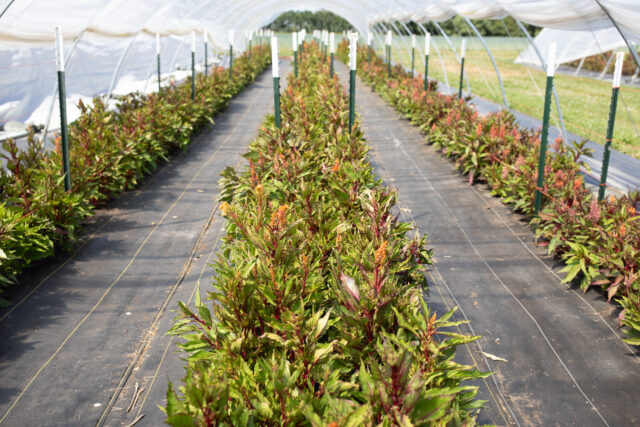 برای واریته های بلندتر، حتماً گیاهان را به صورت مرجانی یا چوبی قرار دهید تا از رشد سرسبز آنها حمایت کرده و از واژگون شدن گیاهان جلوگیری کنید.
برای واریته های بلندتر، حتماً گیاهان را به صورت مرجانی یا چوبی قرار دهید تا از رشد سرسبز آنها حمایت کرده و از واژگون شدن گیاهان جلوگیری کنید.  اگر سلوزیا خود را در ردیفهای بلند بکارید، میتوان آنها را با کوبیدن پایههای سنگین یا تیرهای T در اطراف محیط بستر و با استفاده از ریسمان مهارکننده برای ایجاد جعبهای با خط ریسمان برای ایستادن گیاهان جمع کرد. اگر آنها در چشم انداز رشد می کنند، گیاهان جداگانه را می توان با استفاده از ریسمان به چوب گره زد.
اگر سلوزیا خود را در ردیفهای بلند بکارید، میتوان آنها را با کوبیدن پایههای سنگین یا تیرهای T در اطراف محیط بستر و با استفاده از ریسمان مهارکننده برای ایجاد جعبهای با خط ریسمان برای ایستادن گیاهان جمع کرد. اگر آنها در چشم انداز رشد می کنند، گیاهان جداگانه را می توان با استفاده از ریسمان به چوب گره زد.  سر گل ها با بالغ شدن بزرگتر می شوند، بنابراین زمانی که به اندازه دلخواه شما هستند اما قبل از اینکه به دانه بروند، آنها را بچینید. 80 درصد از شاخ و برگ را در طول برداشت جدا کنید، زیرا مدت ها قبل از محو شدن سر گل در گلدان پژمرده می شود.
سر گل ها با بالغ شدن بزرگتر می شوند، بنابراین زمانی که به اندازه دلخواه شما هستند اما قبل از اینکه به دانه بروند، آنها را بچینید. 80 درصد از شاخ و برگ را در طول برداشت جدا کنید، زیرا مدت ها قبل از محو شدن سر گل در گلدان پژمرده می شود. 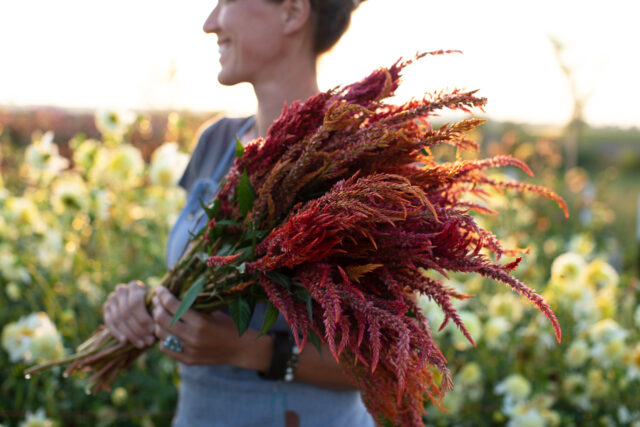 سلوزیا یک گل شاخه بریده با ماندگاری دیوانه کننده است و اغلب تا 2 هفته بدون مواد نگهدارنده باقی می ماند.
سلوزیا یک گل شاخه بریده با ماندگاری دیوانه کننده است و اغلب تا 2 هفته بدون مواد نگهدارنده باقی می ماند.  سلوزیاها اغلب نادیده گرفته می شوند و بیشتر به عنوان یک شاخ و برگ یا پرکننده در نظر گرفته می شوند. با این حال، هنگامی که تمام اشکال، اندازهها و رنگهای موجود و تطبیق پذیری آنها را برای چیدمان کشف کردید، قلاب خواهید شد. بعلاوه، آنها یکی از ساده ترین گل ها برای نجات دانه ها هستند.
سلوزیاها اغلب نادیده گرفته می شوند و بیشتر به عنوان یک شاخ و برگ یا پرکننده در نظر گرفته می شوند. با این حال، هنگامی که تمام اشکال، اندازهها و رنگهای موجود و تطبیق پذیری آنها را برای چیدمان کشف کردید، قلاب خواهید شد. بعلاوه، آنها یکی از ساده ترین گل ها برای نجات دانه ها هستند.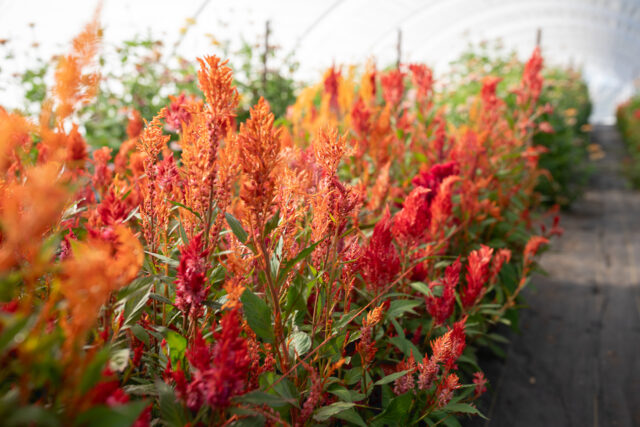 من دوست دارم در مورد تجربه شما در مورد این گروه شگفت انگیز از گیاهان بشنوم. آیا سلوسیا را پرورش می دهید یا قصد دارید آنها را در فصل آینده به باغ خود اضافه کنید؟ اگر چنین است، انواع مورد علاقه شما کدامند؟
من دوست دارم در مورد تجربه شما در مورد این گروه شگفت انگیز از گیاهان بشنوم. آیا سلوسیا را پرورش می دهید یا قصد دارید آنها را در فصل آینده به باغ خود اضافه کنید؟ اگر چنین است، انواع مورد علاقه شما کدامند؟
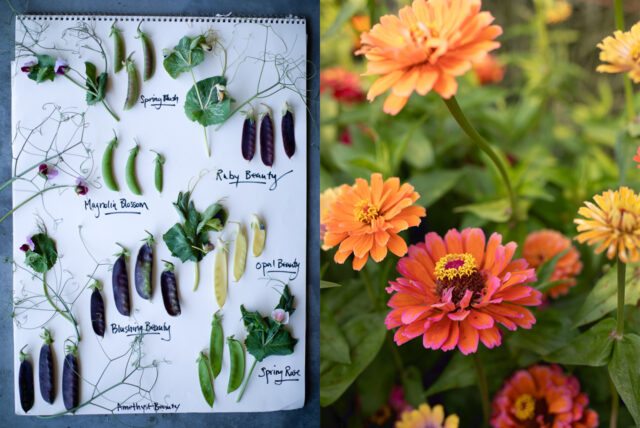 Last season I trialed all of their pea varieties that are part of their breeding program. I was incredibly impressed—they were all beautiful and delicious, and like nothing I’d ever grown before. If you’re looking for some fun and tasty additions to your garden, be sure to check them out!
Last season I trialed all of their pea varieties that are part of their breeding program. I was incredibly impressed—they were all beautiful and delicious, and like nothing I’d ever grown before. If you’re looking for some fun and tasty additions to your garden, be sure to check them out! Dylana, I’m so happy I found out about your operation, and I’m really excited to introduce you to Floret readers. Can you share a little bit about the evolution of your seed company? From what I’ve read, the original Peace Seeds was founded in the 1970s by your parents, but more recently, you’ve renamed it Peace Seedlings. Can you talk about this transition and what you’re focusing on now?
Dylana, I’m so happy I found out about your operation, and I’m really excited to introduce you to Floret readers. Can you share a little bit about the evolution of your seed company? From what I’ve read, the original Peace Seeds was founded in the 1970s by your parents, but more recently, you’ve renamed it Peace Seedlings. Can you talk about this transition and what you’re focusing on now? We were too young to think through how much we would confuse people who thought we sold seedlings, or why two different seed companies worked together on the same 3-acre piece of land that Mushroom and Linda had been leasing since the early ‘90s.
We were too young to think through how much we would confuse people who thought we sold seedlings, or why two different seed companies worked together on the same 3-acre piece of land that Mushroom and Linda had been leasing since the early ‘90s. 
 We’ve generally tried to be more diversified than specialized, but we have ended up being more attracted to certain plants for various reasons. We have done most of our breeding efforts in peas, corn, tomatoes, peppers, beans, marigolds, zinnias, sunflowers, and asters.
We’ve generally tried to be more diversified than specialized, but we have ended up being more attracted to certain plants for various reasons. We have done most of our breeding efforts in peas, corn, tomatoes, peppers, beans, marigolds, zinnias, sunflowers, and asters. This past season we trialed all of your zinnia mixes and were amazed by the uniqueness and diversity found in each collection. I’ve never seen anything like them before! Would you be willing to share a little more about how these varieties came to be, especially the Day Glow Mix?
This past season we trialed all of your zinnia mixes and were amazed by the uniqueness and diversity found in each collection. I’ve never seen anything like them before! Would you be willing to share a little more about how these varieties came to be, especially the Day Glow Mix? Simultaneously we grew out as many zinnias as we could find in the commercial market that had unique colors or morphology and were tall enough for cut flowers.
Simultaneously we grew out as many zinnias as we could find in the commercial market that had unique colors or morphology and were tall enough for cut flowers. 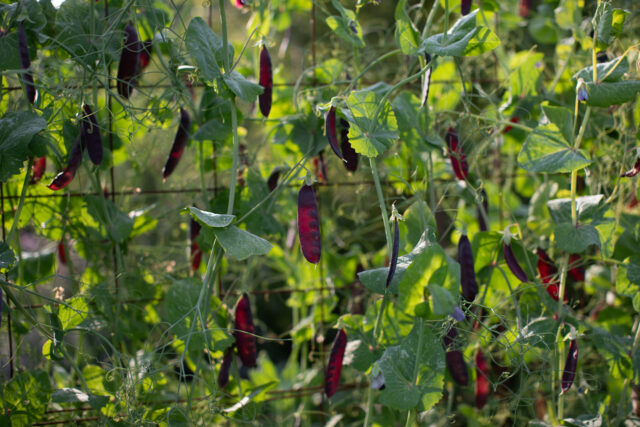 In addition to trialing your zinnias, I also grew all of your snow and snap pea varieties, including ‘Ruby Beauty’, ‘Blushing Beauty’, ‘Amethyst Beauty’ (pictured above), ‘Opal Beauty’, ‘Spring Rose’, ‘Magnolia Blossom’, and ‘Spring Blush’. I was blown away by the range of unique colors and exaggerated tendrils on many of the varieties. They were all incredibly delicious, too. Can you share a little bit more about your pea breeding efforts and a few of your favorites or new varieties that you’d recommend trying?
In addition to trialing your zinnias, I also grew all of your snow and snap pea varieties, including ‘Ruby Beauty’, ‘Blushing Beauty’, ‘Amethyst Beauty’ (pictured above), ‘Opal Beauty’, ‘Spring Rose’, ‘Magnolia Blossom’, and ‘Spring Blush’. I was blown away by the range of unique colors and exaggerated tendrils on many of the varieties. They were all incredibly delicious, too. Can you share a little bit more about your pea breeding efforts and a few of your favorites or new varieties that you’d recommend trying?  The first pea we bred came from being enchanted by a pink-flowered New Zealand pea that a friend was growing and we knew we needed to use that as a parent. Using that pink-flowered pea crossed with ‘Green Beauty’ we made ‘Spring Rose’ (pictured above), which had the unique pink flower trait we were looking for. We hoped crossing yellow peas with purple peas would open up the possibilities of color and hopefully make a “red” pea.
The first pea we bred came from being enchanted by a pink-flowered New Zealand pea that a friend was growing and we knew we needed to use that as a parent. Using that pink-flowered pea crossed with ‘Green Beauty’ we made ‘Spring Rose’ (pictured above), which had the unique pink flower trait we were looking for. We hoped crossing yellow peas with purple peas would open up the possibilities of color and hopefully make a “red” pea. 
 New Peace Seedlings peas include ‘Opal Beauty’ (a golden snow vine pea; pictured above, top left), ‘Amethyst Beauty’ (a purple snow vine pea), and ‘Blushing Beauty’ (a purple splash over green snow pea); two beautiful magenta-colored varieties named ‘Ruby Beauty’ (a snow vine pea; pictured above, top right) and ‘Ruby Crescent’ (a snap vine pea); plus, ‘Opal Crescent’ (a yellow snap pea; pictured above, bottom left), ‘Purple Beauty’ (a dark purple snow pea; pictured above, bottom right), and ‘Sweet Rain’ (an XL green snap pea).
New Peace Seedlings peas include ‘Opal Beauty’ (a golden snow vine pea; pictured above, top left), ‘Amethyst Beauty’ (a purple snow vine pea), and ‘Blushing Beauty’ (a purple splash over green snow pea); two beautiful magenta-colored varieties named ‘Ruby Beauty’ (a snow vine pea; pictured above, top right) and ‘Ruby Crescent’ (a snap vine pea); plus, ‘Opal Crescent’ (a yellow snap pea; pictured above, bottom left), ‘Purple Beauty’ (a dark purple snow pea; pictured above, bottom right), and ‘Sweet Rain’ (an XL green snap pea).
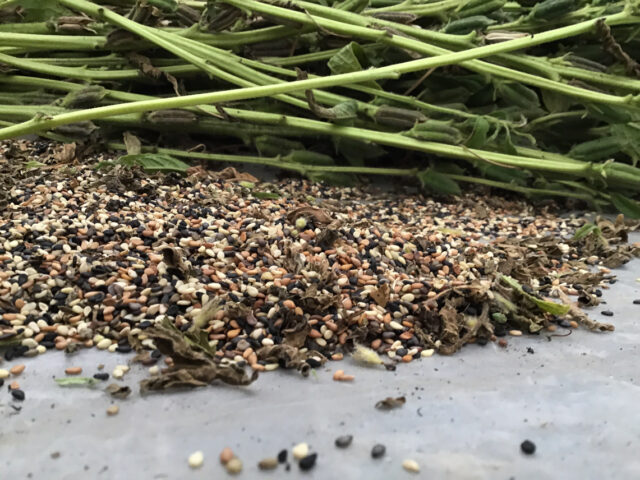 All of the varieties that you offer are open-pollinated and public domain. Can you explain a little more about what it means for a variety to be in the public domain, and why it’s important to you to offer these varieties?
All of the varieties that you offer are open-pollinated and public domain. Can you explain a little more about what it means for a variety to be in the public domain, and why it’s important to you to offer these varieties? While you breed new varieties, you also focus on the preservation of heirloom varieties, which is wonderful to see. How did you become interested in preservation?
While you breed new varieties, you also focus on the preservation of heirloom varieties, which is wonderful to see. How did you become interested in preservation? I have to say, I love that you’re still doing business in the old-school way with a simple listing of your offerings and requiring people to mail in a handwritten order along with their payment. It’s such a refreshing change from the fast-paced digital world that I’m used to. For readers who haven’t ordered from you before, can you walk us through the process of ordering your seeds?
I have to say, I love that you’re still doing business in the old-school way with a simple listing of your offerings and requiring people to mail in a handwritten order along with their payment. It’s such a refreshing change from the fast-paced digital world that I’m used to. For readers who haven’t ordered from you before, can you walk us through the process of ordering your seeds?
 To accompany this interview, we’re giving away five special seed bundles. Each bundle will contain Peace Seedlings special Day Glow Mix zinnias, ‘Spring Blush’ snap peas, and ‘Ruby Beauty’ snow peas.
To accompany this interview, we’re giving away five special seed bundles. Each bundle will contain Peace Seedlings special Day Glow Mix zinnias, ‘Spring Blush’ snap peas, and ‘Ruby Beauty’ snow peas.